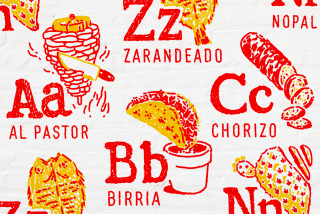Coca: It’s Spanish for pizza

- Share via
“EXPECT the expected” is usually the best slogan when you’re invited for brunch, but what a new friend had waiting on his kitchen counter a few Saturdays ago was not just a fresh idea. It could be the greatest thing since sliced pizza.
My host, a writer and obsessive cook recently back from Barcelona, Spain, had baked his rendition of coca -- a dish he had found everywhere there: a flatbread with caramelized onions, red peppers, summer squash and Spanish sausage. The dough, enriched with seriously good olive oil, had been too sticky to transfer to his pizza stone, though, so he had converted the coca into what he joked was a Catalan calzone with the topping folded inside. It wasn’t pretty, but it tasted fabulous.
A little research made a coca seem even more tantalizing, and not just for brunch but for any eating occasion. I learned that the flatbread can be topped with just about anything savory, whether mushrooms or spinach, olives or anchovies, ham, bacon, tomatoes or even a combination of onion and honey. But it is almost as commonly given the sweet treatment, baked with a topping of sugar, pine nuts and anisette, or citrus rind and sugar. The base is nearly always made with a light but rich yeast dough, something like a dense focaccia, but it can take on other forms closer to a pâté brisée, with lard adding flakiness. The one hard-and-fast rule is that the quality of the ingredients is key: With such an elemental creation, only the best is good enough.
And after experimenting for a few days, I can say coca might even be better than pizza. The dough for the latter is tricky, and the super-hot baking temperature is tough to get right in a home oven. But a coca is as easy as pie filling: You mix the dough fast, knead it by hand and bake it at roast-chicken setting for perfect results.
Colman Andrews, whose 1988 “Catalan Cuisine” remains the definitive guide to the food of a distinctive region, says a coca is rarely homemade in Spain. Shops there bake them to sell by the piece from 2- to 3-foot-long ovals. “Making bread, making pizza -- people basically don’t do that,” Andrews says. “They buy that stuff.”
But the foundation could not be easier. “It’s bread dough that you roll out flat rather than rise into a loaf,” Andrews says. He added that toppings are generally very simple; “if you start putting different things on it, I don’t know what makes it a coca.”
Andrews, interestingly, got his recipes for coques (the plural form) from a couple of bakers originally from a town west of Barcelona who were then working at La Scala Presto in Brentwood. He says the name coques comes from the Latin word for coquere, to cook, and observes that they differ from pizza in their shape (elongated oval) and the temperature at which they are served, not hot at all.
I thought a coca would be closer to a tarte flambée, the Alsatian flatbread covered with bacon, onions and crème fraîche, but I was set straight by a food writer and recipe tester who once took a class in coques in Mallorca, Spain, where they are also ubiquitous. She agrees that a coca is a dish all its own but notes that it “must have evolved -- or devolved -- in the same way as pizza -- depends who’s making it.”
A couple of cookbooks more recent than Andrews’ yielded good guidance on how to make a sweet coca, with lard for a flakier crust.
You can serve a coca for brunch or breakfast, but it is also the ideal accompaniment for drinks and it makes a great snack. I baked one with pesto spread over the dough and another with just tapenade made from black olives, and small squares of either would make good tapas.
The foolproof simplicity of the dough is the biggest selling point; there is no bad coca. You just soften yeast, mix it into flour, olive oil, salt and water to make a soft dough, then knead for about 10 minutes. Let it rise, stretch it out, top it, bake it and you’re done. The dough is best made by hand because a machine will overheat it.
A little anisette
SLICED, caramelized onions are the most basic topping, but they can be combined with roasted or sautéed red peppers or other vegetables. Like the dough, they need top-grade olive oil, preferably Spanish (which really has a distinctive flavor). Green or black olives or anchovies add a little pungency to the topping.
Sliced sausage or bits of ham can also be arranged over the onions.
A soft Spanish sausage called butifarra is traditional, but good kielbasa or Italian sausage works. Andouille is overpowering, though. Most coques do not have cheese.
The sweet version of coca is made with a flaky dough that calls for good lard (or softened butter). The traditional topping is just pine nuts, sugar and a sprinkling of anisette, which Andrews notes is a favorite taste in Catalonia, Spain. But my new coca connection says a mixture of sugar and orange or lemon rind with liquor is also common.
And that may be the best selling point for coca: Anything that can go savory or sweet can start or end a brunch a whole new way.
More to Read
Sign up for The Wild
We’ll help you find the best places to hike, bike and run, as well as the perfect silent spots for meditation and yoga.
You may occasionally receive promotional content from the Los Angeles Times.










